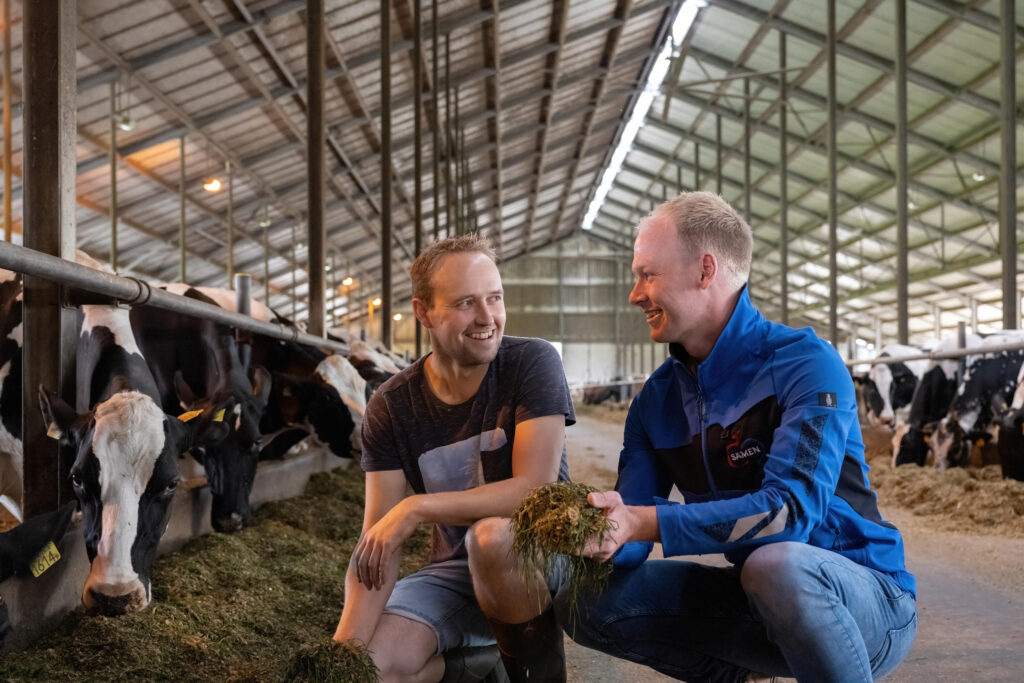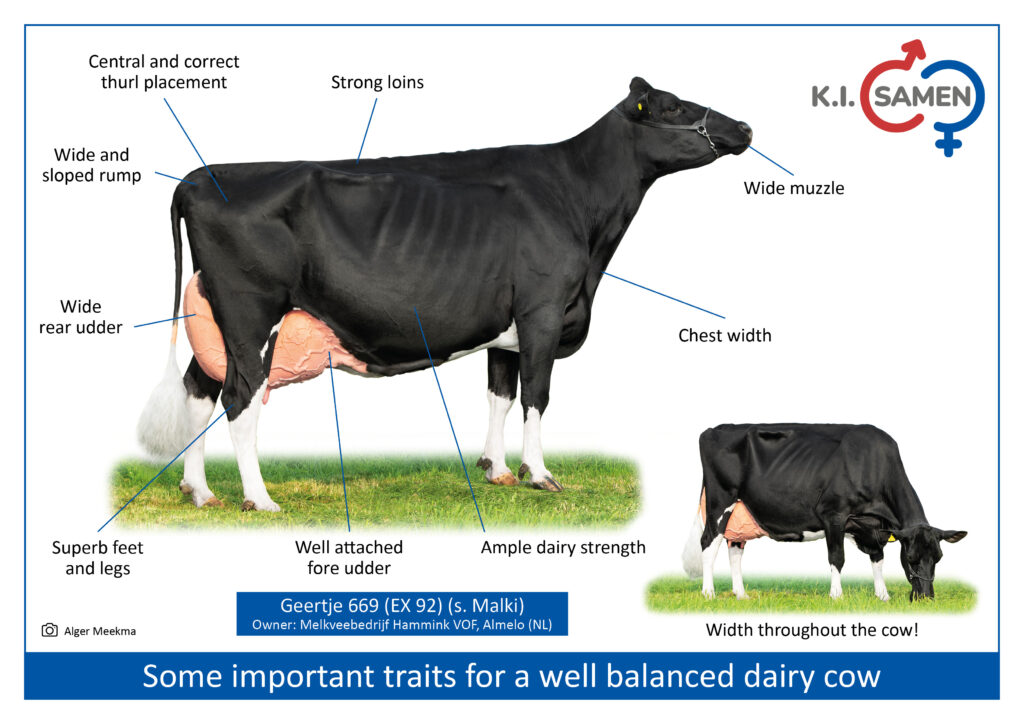FEED EFFICIENCY: WHAT IS REALLY IMPORTANT FOR A HIGH FEED INTAKE?
The index run of April 2022 now includes feed efficiency as one of the breeding values used in the calculation of the NVI. AI organisations that apply this breeding value will be designated a higher NVI ranking than other AI organisations. But is the ‘feed efficiency’ breeding value something that farmers are actually waiting for, or do you see your feed efficiency – just like K.I. SAMEN– from a practical perspective?

“There are many practical approaches on which the high feed intake is based”
Henk Brons
Breeding cows that convert forage to milk
For more than 40 years, K.I. SAMEN has taken a highly practical approach to breeding. This practicality also extends to how the organisation views feed efficiency. Henk Brons: “For us, feed efficiency cannot be defined in a breeding value. No matter how good the feed efficiency of a calf, heifer or dairy cow actually is, we look at the entire picture of development and the animal’s build. There are many practical traits that determine a cow’s ability to intake forage. Our vision of breeding aims to produce a practical cow able to intake a lot of forage and convert it into milk.”
A cow needs to be well balanced for a good forage intake
Stature is a key trait in a cow’s conformation. Henk Brons: “The height of cows in increasing around the world. But grass does not grow in trees and feed is not – usually – presented in an elevated trough. Cows are not giraffes; they still have to bend to reach their feed ration on most farms. Size in itself in not a condition for high milk production. But in our opinion, stature really is an optimal trait. “The majority of cows that produce 100,000 kg of milk in the Netherlands were – and are not – the largest in size. However, thanks to their good feed intake capacity, they manage to achieve this remarkable performance. So bending down to eat should not involve excessive effort! A cow of average stature has no problems at all reaching her feed.”
“The majority of cows that produce 100,000 kg of milk are of modest stature, but have the capacity to intake a lot of forage”
A balanced dairy cow for a good forage intake
K.I. SAMEN is happy to show practical results as proof. Geertje 669 owned by Hammink VOF in Almelo is a prime example of what we consider a well balanced dairy cow. Geertje 669 measures ‘just’ 1.52 metres at her withers, but she excels in production! She combines fabulous milk yields with good body condition and scores EX 92 for conformation. We have used her photo to illustrate some important traits that are vital for a good dairy cow; a cow that performs well thanks to her good forage intake capacity.
Better forage intake? Look at your cow!
A well balanced cow has a better forage intake. We have listed a number of important traits that contribute to a well balanced dairy cow:

1 Wide muzzle for high feed intake
We like to see cows with a wide muzzle. A wide muzzle is often associated with a wide jaw (sufficient width between the eyes) that facilitates a high feed intake. Each time she takes a bite, she can consume more feed (grass). This means a higher energy intake using less of her own energy. The rumen does the rest. Rumination is easier for cows with a wider muzzle. More rumen activity means better utilisation of the feed.
The other advantage of a wide muzzle is that the cow can dissipate heat better. Cows do not have the same capacity to sweat as humans, they have to get rid of excess heat via the muzzle. A wide muzzle can also process larger amounts of feed faster. A good dairy cow has the ability to consume a lot of feed.
2 Sufficient chest width
Another major contributing factor to milk production is sufficient chest width. The chest is where the heart and lungs are found. For each kilogram of milk, 300-400 litres of blood must be pumped around the body. This implies the best possible heart and lung functionality. Cows with a too narrow chest lack this functionality, so at K.I. SAMEN we prefer animals with a generous chest width. But too much is never a good thing. Cows that have too much chest width are unable to optimally convert forage into milk. Cows with a good chest width often have straighter legs, move with ease and are first at the feed fence.
3 Ample dairy strength enables good digestion
A cow with sufficient space between the ribs shows ample diary strength, which is vital for a good forage intake. There must be enough space for the rumen behind the chest area. This is where the feed is digested. Cows with a high feed intake have ample capacity. Without this they are unable to optimally utilise and convert their feed and will quickly produce too much milk relative to their build. This soon has negative consequences. In addition, we also like to see cows with a well-defined wedge shape, as this also contributes to a good feed intake.
4 Strong loins, a vital element of good feed intake
It is essential that a cow has sufficiently strong loins. The loins connect the hindquarters – i.e the udders – and the power house of the cow – i.e the chest and ribs. Strong loins are absolutely essential for the cow’s overall functionality. The wider the rump, the stronger the loins must be. The space for the udder is also considerably larger. More space for the mammary gland (udder) can therefore also result in higher milk production. Here too balance is key, so not just chest width, but also good width in the loins and width between the hips. Cows with wide loins also often have a wide head. The cow must be in proportion, creating a balanced, pleasing picture. A cow with ample capacity but a narrow head has space but no way of delivering the fuel to power it.
5 Correct feet and legs to reach the feed fence

feed should not be an effort!
Cows with a high feed intake generally also stand on correctly positioned legs. A good leg position means there is even pressure distribution on the inner and outer claw. The chest must be wide enough to allow a good leg position. Narrow-chested cows are more likely to be splayfooted. Seen from the front, the knees are close together and the feet toe out away from each other. The cow assumes this position because she is trying to stabilise herself, however her chest is too narrow to allow her to place her feet facing forward. Excessive pressure is exerted on the inner claw which leads to problems. A cow that experiences claw problems will rest for longer and not eat enough, starting a negative, vicious circle that is difficult to break. A good build with ample width ensures a healthier, more vital cow. This type of cow will be a longer lasting member of the herd with fewer problems and will deliver higher financial gains for the farmer.

A well balanced cow provides more job satisfaction and income
Henk Brons: The photo of Geertje 669 shows various important traits. All these traits deserve attention; they may not all directly affect the feed intake and digestion, but certainly have an indirect impact. A well balanced cow is and remains the foundation of a healthy, durable dairy cow. A well built structure resting on firm foundations ensures enjoyment at work and profitability.






